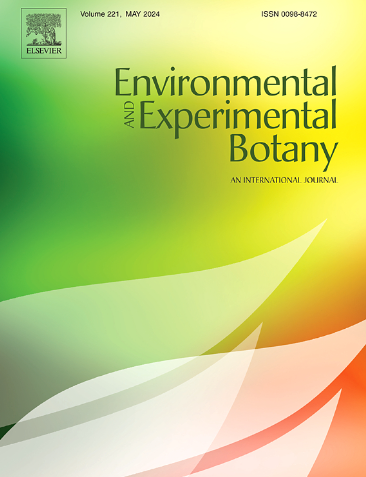Comparative analysis of photosynthetic heat tolerance mechanisms in select Rubus subgenus Idaeobataus species using a numerical modeling and partitioning approach
IF 4.7
2区 生物学
Q2 ENVIRONMENTAL SCIENCES
引用次数: 0
Abstract
The cultivated red raspberry (Rubus idaeus) in the genus Rubus subg. Idaeobatus is an economically valued berry crop but its cultivation has been limited by heat in the warm climate regions. Many species in the same subgenus are native to the subtropics and have been considered as potential germplasms for improving heat tolerance of raspberry cultivars. However, their photosynthetic responses to high temperatures and adaptation mechanisms have not been comprehensively exploited. In this study, leaf gas exchange characters of raspberry ‘Summer Festival’ and three subtropical native species, R. fraxinifolius, R. rosifolius, and R. croceacanthus, were mathematically analyzed. Net photosynthetic assimilation rate (A) and chlorophyll fluorescence against photosynthetic photon flux density (PPFD) and internal carbohydrate concentration (Ci) were measured at 25, 30, and 35℃. Data from the measurements were fitted to modified Farquar, von Cammerer and Berry (FvCB) models and key photosynthetic variables were extracted. Inter- and intra- species differences in A (% ΔA) were quantified by partitioning the total difference into individual and categorized variables using a numerical integration method. The results showed that light saturated A and transpiration (E) of R. idaeus were suppressed at 35℃ while both in the subtropical native species sustained or elevated at the high temperature of 30 and 35℃. The two key photosynthetic biochemical variables, maximum carboxylation rate (Vcmax) and maximum electron transport rate (Jmax), were both increased at high temperatures in all studied taxa. Nevertheless, the superior A of the subtropical species was mainly contributed by the improved diffusional factors, i.e., stomatal conductance (gsc) and mesophyll conductance (gm), in response to elevated temperatures. This study demonstrated that the select subtropical native species better adapt to heat than the cultivated raspberry by maintaining leaf temperature low and photosynthetic efficiency high through consistent gsc and improved gm. The information suggested that for breeding programs targeting on heat tolerance, screening candidate genotypes with photosynthetic diffusional factors should be more efficient than evaluating biochemical factors. The results also provide useful references for raspberry industry to develop cultivation strategies to alleviate the impact from intensifying climate change situations.
采用数值模拟和划分方法比较分析了不同品种的光合耐热性
栽培的红树莓属(红树莓属)。冰果是一种具有经济价值的浆果作物,但在温暖气候地区,它的种植受到高温的限制。同一亚属的许多种原产于亚热带,已被认为是提高树莓品种耐热性的潜在种质。然而,它们对高温的光合反应和适应机制尚未得到全面的研究。本文对夏节覆盆子与3种亚热带原生种rafxinifolius、rasifolius和rcroceacanthus的叶片气体交换特性进行了数学分析。测定了25、30和35℃下净光合同化率(A)和叶绿素荧光对光合光子通量密度(PPFD)和体内碳水化合物浓度(Ci)的影响。测量数据被拟合到修正的Farquar, von Cammerer和Berry (FvCB)模型中,并提取了关键的光合变量。A (% ΔA)的种间和种内差异通过数值积分法将总差异划分为个体变量和分类变量来量化。结果表明:35℃条件下,idea aeus的光饱和A和蒸腾E受到抑制,而30和35℃的高温条件下,idea aeus的光饱和A和蒸腾E维持或升高。两个关键的光合生化指标,最大羧化速率(Vcmax)和最大电子传递速率(Jmax)在高温下均有所升高。然而,亚热带树种的优越A主要是由于温度升高导致气孔导度(gsc)和叶肉导度(gm)等扩散因子的改善。本研究表明,通过一致的gsc和改良的gm,所选择的亚热带本地种比栽培树莓更能适应高温,保持叶片温度低,光合效率高。这些信息表明,在以耐热性为目标的育种计划中,利用光合扩散因子筛选候选基因型比评估生化因子更有效。研究结果也为树莓产业制定相应的种植策略以缓解日益加剧的气候变化影响提供了有益的参考。
本文章由计算机程序翻译,如有差异,请以英文原文为准。
求助全文
约1分钟内获得全文
求助全文
来源期刊

Environmental and Experimental Botany
环境科学-环境科学
CiteScore
9.30
自引率
5.30%
发文量
342
审稿时长
26 days
期刊介绍:
Environmental and Experimental Botany (EEB) publishes research papers on the physical, chemical, biological, molecular mechanisms and processes involved in the responses of plants to their environment.
In addition to research papers, the journal includes review articles. Submission is in agreement with the Editors-in-Chief.
The Journal also publishes special issues which are built by invited guest editors and are related to the main themes of EEB.
The areas covered by the Journal include:
(1) Responses of plants to heavy metals and pollutants
(2) Plant/water interactions (salinity, drought, flooding)
(3) Responses of plants to radiations ranging from UV-B to infrared
(4) Plant/atmosphere relations (ozone, CO2 , temperature)
(5) Global change impacts on plant ecophysiology
(6) Biotic interactions involving environmental factors.
 求助内容:
求助内容: 应助结果提醒方式:
应助结果提醒方式:


